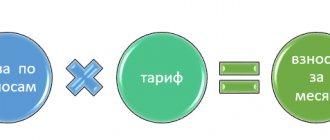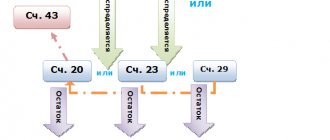In this article we will look at how relationships with customers are taken into account in accounting. Which account is used to record customers, what postings are made. Transactions during a regular sale, upon receipt of an advance from a buyer or a bill of exchange are considered.
To account for settlements with buyers, account 62 “Settlements with buyers” is used, the debit of which reflects the buyer’s debt to the seller, and the credit reflects payment for goods, work, and services.
Buyers can pay the seller either after receiving the goods, or by making an advance payment, that is, by transferring the advance to the seller’s bank account. Payment by the buyer for the goods is made on the basis of an issued invoice, a sample of which can be viewed here.
Accounting for settlements with customers during sales
Revenue from the sale of goods (work, services) is recognized as income from an ordinary type of activity and is reflected in the credit of account 90 “Sales”.
If the sale is one-time and is not a regular activity of the enterprise (for example, the sale of a fixed asset), then the proceeds are reflected as part of other income under the credit of account 91 “Other income and expenses”.
These two accounts 90 and 91 will be discussed in detail a little later; they are interesting and unlike other accounts, they have their own characteristics. It is necessary to calculate VAT on the sale price of goods (works, services) and send it for payment.
| ★ Best-selling book “Accounting from scratch” for dummies (understand how to do accounting in 72 hours) > 8000 books purchased |
Postings to account 62 during regular sales: (click to expand)
| Debit | Credit | Operation name |
| 62 | 90/1 | Revenue from the sale of goods (works, services) is reflected |
| 90/3 | 68 | VAT accrued on goods sold (work, services) |
| 62 | 91/1 | Revenue from the sale of fixed assets, intangible assets, materials is reflected |
| 91/2 | 68 | VAT accrued on sold assets |
| 51 | 62 | Payment received from buyer |
Account 62 in accounting
Settlements are reflected in correspondence with the account. 90 “Sales” and 91 “Other income and expenses”, for which settlement documents were provided:
Account 62 has two sub-accounts - account 62.01 and 62.02:
- account 62.01 shows the amount of income. Debit turnover reflects the amount of shipped products, goods, and services. Loan turnover is the amount received from customers.
- account 62.02 shows information about advances received from customers. Debit turnover reflects the shipment made against advances. Loan turnover is the amount of advances received from customers.
Accounting for advances received in settlements with customers
If the buyer pays for the goods in advance and makes an advance payment, then to account for settlements with buyers, in this case, subaccount 2 “advance received” is opened on account 62, while subaccount 1 will reflect settlements with buyers in the general case.
VAT is considered and payable on advances received. Then, when goods, works or services are transferred to the buyer, VAT is charged again, this time on the proceeds. The accrued amount of VAT on the advance received is restored, and then an entry is made to offset the advance. You can read more about accounting for VAT on advance payments in the article: “Accounting for VAT on advance payments and gratuitous transfers.”
Postings for accounting for advances received (account 62)
| Debit | Credit | Operation name |
| 51 | 62. Advance received | An advance was received from the buyer to the bank account |
| 76.VAT on advances received | 68 | VAT is charged on the advance received |
| 62/1 | 90/1 | Revenue from sales of goods is reflected |
| 90/3 | 68 | VAT accrued on goods sold |
| 62. Advance received | 62/1 | Offset of advance against debt repayment |
| 68 | 76.VAT on advances received | Accepted for deduction of VAT in connection with the sale of goods paid in advance |
Payments by bill of exchange
The instructions for the chart of accounts also pay attention to the peculiarities of settlements with bills of exchange. If the buyer issues his own bill of exchange to the supplier, then the debt is not repaid, but by this action a deferred payment is issued and a guarantee of payment is issued. To account for bills received, it is recommended to allocate a separate sub-account, for example, 62.3 “Bills received”. The following entries are made in the seller's accounting:
| Dt | CT | Description |
| 62.1 | 90.1 | Revenue accrued |
| 90.3 | 68 subaccount “VAT” | VAT charged on sales |
| 62.3 | 62.1 | Received own bill from buyer |
| 51 | 62.3 | Received funds upon presentation of a bill of exchange |
| 51 | 91.1 | Interest received on the bill |
Another situation arises if the debt is paid by a bill of exchange from third parties. Such a bill of exchange is recognized as a financial investment and is accounted for in account 58. The entries shown in the table are made in the supplier’s accounting:
| Dt | CT | Description |
| 62.1 | 90.1 | Revenue accrued |
| 90.3 | 68 subaccount “VAT” | VAT charged on sales |
| 58.2 | 62.1 | Received a third party promissory note as payment |
Accounting for bills received from the buyer:
If the buyer issued a promissory note to the seller, it must be accounted for in subaccount 3 “Bill of note received” of account 62. After the sale of the product, posting D51 K62. Bill of exchange received - this bill is repaid.
If the nominal value of a bill of exchange received exceeds the sale price, then the excess amount is reflected in entry D62. Bill of exchange received K 90/1.
Postings to account 62 when paying by bill of exchange:
| Debit | Credit | Operation name |
| 62 | 90/1 | Revenue from the sale of goods is reflected. Accounting for a bill received from the buyer. |
| 62.Bill received | 62/1 | The bill received from the buyer was taken into account |
| 51 | 62.Bill received | The received bill is repaid |
| 62.Bill received | 90/1 | The excess of the nominal value of the bill over the sale price is reflected |
What transactions are reflected in account 62 in accounting?
According to the recommended Chart of Accounts, a business entity must use account 62 to record transactions with buyers and customers.
The law establishes that two types of debts must be kept in the account:
- To the company for goods sold, or work and services performed;
- To buyers for advances received from them.
When selling products or performing work, it must be immediately shown in the debit of the account. At the same time, the same amount is indicated on the sales accounts (90, 91) or the gradual execution of work. After receiving payment from the counterparty, it should be reflected on the credit of the account, simultaneously with the debit of the cash settlement accounts.
If the buyer makes payment before actually receiving goods or work, then this receipt is reflected in account 62 as an advance received. Since this amount is accounts payable, it must be recorded in separate accounts. It is not possible to show both debts collapsed.
Also, the buyer may not repay the debt, but issue his own bill. This paper will act as a deferment of payment and a guarantee of further repayment of the debt.
Attention! This kind of payment must be taken into account in account 62, but separately from simple debt. However, if the buyer issues a third party’s bill of exchange as payment, then such a step is already recognized as a financial investment and is subject to accounting on account 58.
An example of accounting for settlements with buyers and customers. Postings
| The organization Alpha LLC received an advance payment from the Beta LLC company for the shipment of finished products in the amount of 236,000 rubles. A week later, I shipped part of the finished products worth 47,200 rubles. (including VAT RUB 7,200) How to account for these transactions? |
In fact, account 62 “Settlements with buyers” reflects the buyer’s debt to the seller, that is, accounts receivable. Postings to account 62 are made at the time the sale is made, that is, at the time the goods are shipped.
Thus, account 62 reflects settlements with customers and 3 sub-accounts can be opened on it: (click to expand)
- subaccount 1 – to reflect settlements for regular sales;
- subaccount 2 – to account for the advance received;
- subaccount 3 – for accounting for bills received.
In the next article we will look at how to carry out accounting of accounts payable: “Accounting for short-term and long-term loans and borrowings (accounts 66 and 67)“.
Balance sheet for account 62
It is important before closing the month and drawing up a report on the financial condition of the enterprise to check that the accounting registers are filled out correctly. One of the verification options is the formation of a balance sheet (hereinafter referred to as TSA) for the period under audit:
What the balance sheet shows for account 62 and how to read SALT is shown in the following table:
| Accounting section name | Initial balance | Turnover for the period | Final balance | |||
| Debit | Credit | Debit | Credit | Debit | Credit | |
| Score 62 | Buyer's debt balance | Remaining debt to the buyer | Amount of shipped products (goods, services) | Payment from buyers for the period | Buyer's debt balance | Remaining debt to the buyer |
An organization is usually created to make a profit. She can do this when selling goods or performing any services. Thus, the business entity acts as a seller and must keep records not only of shipped goods and materials or completed work, but also of received payments. The current Chart of Accounts provides for these purposes account 62 in the accounting “Settlements with buyers and customers”.
Typical transactions for account 62
Postings to account 62 are drawn up in correspondence with the accounts specified in Order of the Ministry of Finance of the Russian Federation dated October 31, 2000 No. 94n.
Examples of debit entries:
Typical loan transactions:
Organizations that apply the general taxation system and include VAT amounts in the cost of their goods and services charge them to account 62 both upon shipment and upon crediting payment for shipped goods, including advances. Let's consider an example of VAT accounting in the light of the functioning of account 62.
Example
Subscribe to our newsletter
08/01/2018 LLC "Princip" received an advance to the bank account for the upcoming shipment of goods from LLC "Pir" in the amount of 10,000.00 rubles, including VAT 18% - 1525.42 rubles.
The total amount of the contract is RUB 30,000.00, including VAT 18% - RUB 4,576.27.
On August 13, 2018, goods were shipped in the amount of RUB 30,000.00, including VAT 18% - RUB 4,576.27.
On August 15, 2018, Pir LLC transferred 20,000.00 rubles, including VAT 18% - 3,050.85 rubles, to the bank account of Princip LLC as full payment under the contract. The accountant of Principle LLC will make the following entries in the transaction journal.
Credit shows our debt
Account credit 62 shows the amount of debt to clients, that is, accounts payable. By analogy, let's turn to the subaccounts to account 62. On the loan, subaccounts 62.01 reflect payment for shipments of goods (work, services). Moreover, payment can be made not only in money to a current account or to the cash register, but also by a bill of exchange or by offset.
You can find more complete information on the topic in ConsultantPlus. Full and free access to the system for 2 days.
The credit of subaccount 62.02 shows advances received against future shipments of goods. The credit of subaccount 62.03 records the amounts received from debtors in payment of bills received from them. That is, similar to the situation with the debit of the account, any debt incurred by our organization to clients (payment by the buyer of his bill or purchased goods) is reflected in the credit of account 62.





